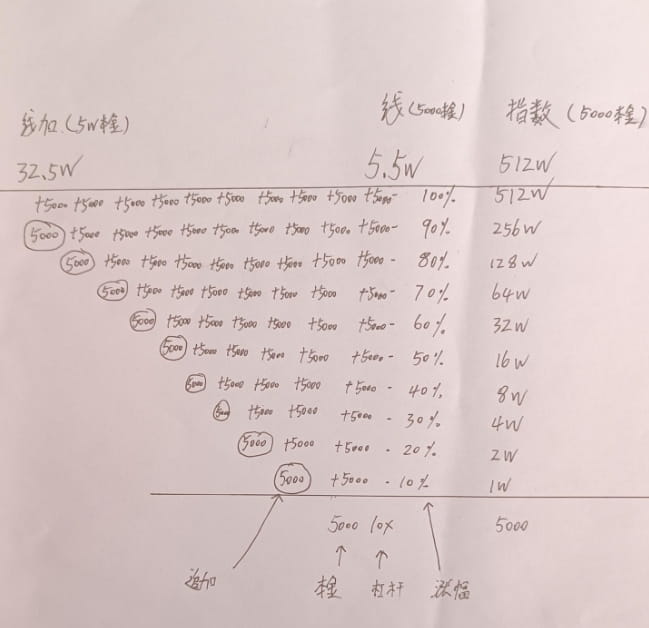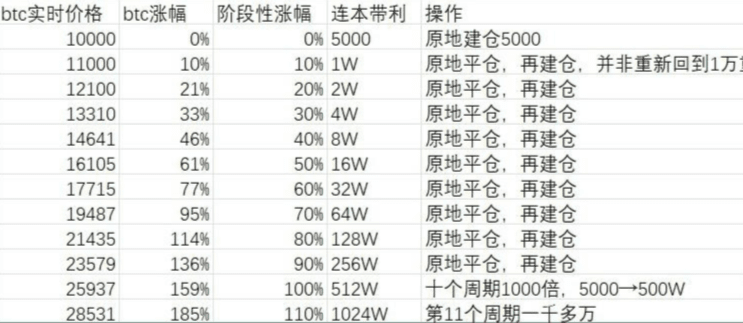First, a summary: Rolling positions are high-yield operations, but they also come with extremely high risks; caution is essential.
The combination of rolling positions (exponential growth) and compound interest is the high cost-performance strategy.
Note that rolling positions lead to exponential growth, while compound interest is a special manifestation of exponential growth.
In other words, all compound interest is exponential growth, but not all exponential growth is compound interest. Spot trading is the compound interest model, while futures trading is more like a linear growth model.
Now let's officially start talking about rolling positions.
With a principal of 5,000 and 10x leverage, a 100% increase results in a final profit of 5 million; this is rolling positions.
Floating profit addition is not rolling positions. Because the current market definitions and methods of rolling positions are all directly copied from Fatty, BitKing, and Tony’s views, it is still not intuitive enough for novices without much investment experience. This article aims to explain in a straightforward manner.
Assuming the current BTC price is 10,000, open a position of 5,000 with 10x leverage. If BTC then rises to 11,000, a 10% increase results in a profit of 5,000. OK, the next operation is very important.
1. The method of floating profit addition is to add another 5,000, and then if BTC rises to 12,000 and increases by 10%, your total principal and interest would be 25,000. (Principal: two 5,000 + profit: three 5,000)
2. The approach to rolling positions is to close previous positions, combining principal and interest to 10,000, then open new positions. After that, if BTC rises to 12,000, with the same increase of 10%, your total principal and interest would be 20,000.
Looking at it this way, is there really no difference? But as long as you keep operating in cycles, when BTC rises to 20,000, the increase is 100%. The floating profit addition ultimately amounts to 325,000 (including 50,000 principal). Rolling positions amount to 5.12 million (including 5,000 principal).
Why is there such a big gap? Let's analyze it together.
What is a complete position building cycle?
Open position → floating profit → floating profit → close position and exit
What is a complete floating profit addition cycle?
Open position → floating profit → add position → floating profit → close position and exit
What is a complete rolling position cycle?
Open position → floating profit → close position and re-open → floating profit → close position and exit
OK, here are two extended concepts explained in an easy-to-understand manner. One is linear growth, which increases like 10%, 10%, 10%.
One is exponential growth like 10%, 20%, 40%, 80%. Linear growth is like driving where you accelerate smoothly from 10 to 20 to 80.
Exponential growth is like technological development, which grows exponentially; it starts slowly and accelerates over time. Here's an imprecise example for understanding: based on solid evidence, humans fully mastered fire 400,000 years ago, electricity 200 years ago, cars about 100 years ago, the internet 55 years ago, and mobile internet 30 years ago.
In other words, once electricity is skillfully utilized, human technology advances rapidly. Compared to that 400,000 years, it seems trivial. Back to the main topic.
Now let's draw a comparison:
Ordinary position building is linear growth. Strictly speaking, contracts do not count as linear, but for ease of understanding, let's use this analogy.
Floating profit addition is based on linear growth with additional positions.
Rolling positions lead to exponentially multiplied growth.
Below is a manually calculated diagram for a more intuitive look. The 5,000 in circles represents the floating profit plus the additional principal.

At this point, do you think, wow! It's so simple! Isn't this the wealth code? But in reality, the operation of rolling positions has a set of strict necessary conditions: capital management, profit-taking and stop-loss, and the most important prerequisite -- a bull market with one-sided upward trends.
The biggest risk behind such high returns is that encountering a drawdown of more than 10% can lead to total loss. However, I personally believe that through reasonable profit-taking and stop-loss methods, it can still be controlled. If a significant market movement occurs once every four years, it can be utilized.
Summary: The high returns of rolling positions are accompanied by extremely high risks; one must be cautious. The combination of rolling positions (exponential growth) and compound interest is the most cost-effective strategy.
Note that rolling positions lead to exponential growth, while compound interest is a special manifestation of exponential growth; therefore, all compound interest is exponential growth, but not all exponential growth is compound interest. Spot trading is the compound interest model.
Many friends say the increase shown in the diagram is based on 10,000, but you can see the 10% and 20% in the diagram as phased increases; the essence is completely the same. It's just to understand compound interest more intuitively. For detailed information, see the diagram below.

The above analysis shows that the real significance of rolling positions lies in compound interest, and the true meaning of compound interest is to fully mobilize unrealized profits, which is the floating profit part.
BitKing turned 40,000 into 200 million using leverage; the essence is compound interest thinking. Compound interest thinking is the only possibility for turning small capital into large profits. If you think about it, it's the only way! Earning a few waves this week and losing a few waves next week without any rules in futures trading means not only failing to make big money but also being hard-pressed to break even.
Secondary summary: There are three points for making big money with small capital: 1. Compound interest thinking. 2. Bull market. 3. Correct operations. If all three points are met, congratulations, this is a sufficient and necessary condition for big gains from small investments!
If you are also a tech enthusiast and are delving into technical operations in the crypto world, consider following @钱包守护者 ; you will gain more!